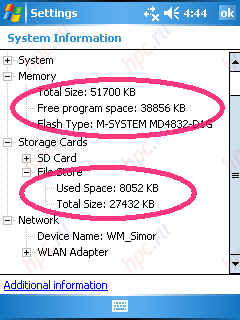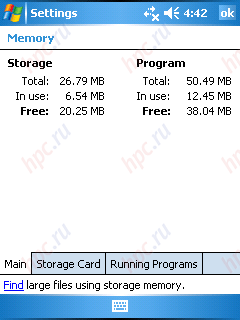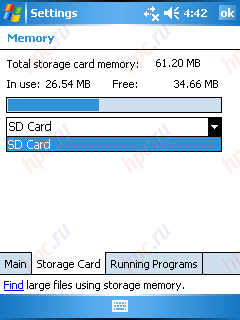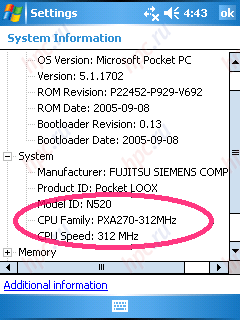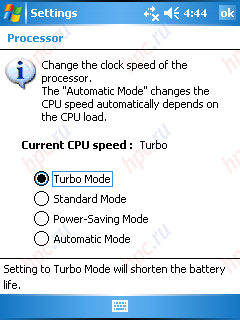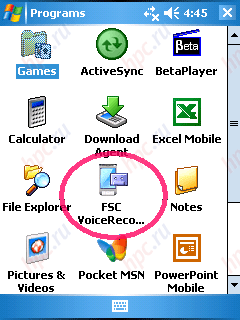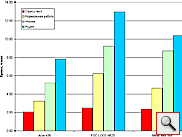To our office got one of the first PDAs running Windows Mobile 5.0 on Fujitsu-Siemens Computers - Pocket LOOX N520. This is a very curious instance with integrated GPS, the output of which, no doubt, many are waiting. However, we offer only a preliminary review of the machine. The fact is that to get the test was only a pre-sale model, which was not activated the same GPS-controller, and there was some software and a complete set of delivery. However, the launch of the Sale FSC Pocket LOOX N520 is planned later this month (well, more would be "no one wants to miss the Christmas sales:). But since even the publication of specifications the device caused no comments on our site, to keep silent about what we learned would be wrong. So get started.
 |
I must say that the FSC does not pioneered the production of PDAs, while its ancestor, Siemens, had experience in manufacturing such devices. The Natural History of the CPC under the brand LOOX began in 2002 when the new OS Pocket PC demanded standardization of the hardware platform, which facilitated the creation of producers of handheld computers. In fairness, it should be noted that because of these veterans on the market right now there is only HP, but from the "Wave 2002" company, FSC can be identified as the creator of sufficiently fast machines with long battery life. After the 600 series followed by 610-I, 700 th and 400 th, almost all of which FSC install the latest processors, operating system or screen. It is not surprising that the Pocket LOOX N520 was one of the first representatives of a PDA running WM 5.0. Incidentally, the letter N in the title stands for typewriter Navigator. Using the fact that the new operating system includes drivers for GPS, satellite signal receiver is built right into the unit (ie there is no fold-up antenna). The fact that the figures the name of the series went down, done, seen, in order to provide a reserve for the future growth of up model range. In the sale will go two models of the series N: 500-I 520-I, roughly similar in configuration, but in the 520-th embedded Wi-Fi (protocol 802.11g) and doubled the amount of flash memory to 128 MB.
Characteristics of FSC Pocket LOOX N520: - Operating system: Windows Mobile 5.0
- Processor: Intel XScale PXA270, 312 MHz
- Memory: 64 MB RAM (memory) and 128 MB ROM (ROM)
- Screen: 3.5 "color transflective, 240 x 320 pixels, 65 thousand colors (a)
- Communications: IrDA, Wi-Fi (802.11g), USB-port, USB-Host
- GPS: Built-in GPS receiver on a chip SiRF Star III, without a retractable antenna
- Expansion slot: SD / MMC / SDIO
- Battery: removable Li-Ion 1200 mAh
- Weight and dimensions: 141 g and 116 x 71 x 14 mm
Compare Ad FSC Pocket LOOX N520 can be a precursor FS Pocket LOOX 420 (without a satellite receiver), the form factor which was taken into service and GPS PDA chip SiRF Star III Asus MyPal A636 (review this PDA expect in the near future), Pocket Navigator PN -169 and Budgetary Acer n35.
 |
| Twins: FS Pocket LOOX 420 Pocket LOOX 520 |
Completion
Again, a copy of a pre-production, so only rely on the local office. Complete c N520 will be supplied cradle, power cord, sync cable c USB-host, as well as CDs with the software company Kiberso "to navigate through the Moscow and an additional set of software. It is interesting that, as a bonus promised to software programs, which are usually lacking in standard PDA, but what is still unknown. Unfortunately, not all of the above was found in a box of our hero, but it costs the engineering model.
Appearance and ergonomics
Model Pocket LOOX N520 to shape resembles its predecessor LOOX 420. Strict rectangular shapes are rounded, which gives the machine elegance. Because of their small size and weight, the CCP fits the hand.
Unlike many other manufacturers FSC made a stylus with a hollow metal body - the pen has turned out a strong and lightweight. With our pre-production samples supplied power adapter, sync cable and docking station. The cable for synchronizing prudently done jack to plug in his cord. And a few words on the dock. It perfectly matched the style to the very device: a compact rectangular platform with rounded edges, a little skirting firmly holds LOOX N520. Design to obtain a stable and looks aesthetically pleasing, a pity that not a separate connector for power - there's only docking connector, and therefore, even while simply charging on the table will confuse cable synchronization.
Controls
Enemies crept into the laboratory Fujitsu Siemens Computers and erased from the drawing the scroll wheel, the one that the LOOX 720, but due to low volume, the PDA is convenient to work with one hand. The thumb easily reaches for a rectangular joystick. Separately, I note that from my point of view of a rectangular shape with a joystick button input in the center - the most successful in the history of the CCP. When using it, there is practically no false positives, the user clearly understands that he has chosen. Also within reach is the button on-off PDA, so that the second hand free exclusively for the operation of the stylus. Nice "trick" - illuminated buttons.
 |
Unit controls include: five-way joystick, buttons Calendar, Contacts, desktop and proprietary utility FSC SpeedMenu - shortcuts to frequently used applications. All the keys are pressed clearly and without any problems. The shell itself is made of the CCP is not very high quality, the panel "walk". Hopefully, the build quality of serial copies be better used for family LOOX not seen this kind of shortcomings. But continue to check the model. On top of the left side N520 is a voice recorder button. Interestingly, the records now knows not only the application Notes, and proprietary software, however, about the software later. Naturally the user is to reprogram this button to "Scroll down" to make it easier to read e-books:) Below is the infrared port.
At the top end as usual placed slot for SD / MMC and the periphery, near the headphone output under ordinary 3,5 mm jack.
Bottom - jack for connecting to a dock or sync cable. Slots for the power cord is not, as in the case of the dock: the cable from the power supply connects to the sync cable. Ibid located recess in which the recessed reset button. The tip of the stylus to easily penetrate into it, so say "goodbye" make-up caps. As we have said above, the serial cable cars will be equipped with USB host for connecting peripherals, but in our set, unfortunately, was not included.
On the reverse side of the battery is located (under cover) and an unusual connector for external antenna GPS. The module SiRF Star III GPS is hidden inside the CCP. Used capacity battery of 1200 mAh, removable design, so that you can not buy spare to extend battery life machines. Only now access to the battery arranged inconveniently - it is difficult to remove the cover.
Speed and memory
Well, here we have reached the most interesting. Unfortunately, with the memory of N520 is not thick. Although the producer and said that amount of RAM - 64 MB ROM - much as 128 MB, but the user can use only 27 MB of flash memory. So with a serious approach to business is not to avoid buying a SD-card. I recall that in Windows Mobile 5.0, both on the desktop, all the memory allocated for the implementation of programs (in this case is about 50.5 MB), that is, user data is now stored in ROM, as usual engine for reallocation disappeared.
Now memory is strictly divided into one in which programs are stored, and the one in which executed.
Flash memory allocated to the user in a vexing little, so that a single flash drive, like the Asus A636, our hero is not available. However, it is not scary, because the new organization of memory, again, in any case ensure the safety of your data.
But continue to check the hardware capabilities of the sample. In LOOX N520 uses 312 MHz processor PXA270.
Traditionally, the user is implemented to control processor performance.
The company chose FSC PXA 270 processor with a relatively low frequency of 312 MHz, but as it turned out, cost-effective. In general, the next experience with Spb Benchmark test showed that the program that must be handled carefully. Unfortunately, the developers are not going in the near future to adapt it to new devices. Thus, under WM5.0 is an application to work properly in tests Pocket Word, Pocket IE and File Explorer, which certainly affected the final results, but they were interesting. For comparison, we chose Acer n35, Asus MyPal A636, and several models of the old wave with PXA processor family 270. Model LOOX N520 passed the test in automatic mode selection performance.
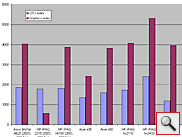 |
Even so LOOX N520, though, and gave the competitors in terms of CPU Index, but also showcased the high-performance graphics-intensive applications that are properly run. I recall that said here Asus A636, running WM5.0, as LOOX N520, but it has a more powerful processor 416 MHz PXA270. Typically, most resursoemkosoemkoe application with which users have to face it playing video. It was logical to see how it shows itself LOOX N520. Below is its performance when running at maximum (312 MHz) and standard (208 MHz) performance, as well as energy saving (the frequency dropped to 104 MHz).
 |
We see that neither the new OS, with its low CPU clock speed did not prevent LOOX N520 show good performance. Another interesting observation was made by a competitor of our hero, Asus MyPal A636, equipped with a flash drive, in addition to the storage of user data in ROM. As it turned out, the speed of video playback from the storage area and a flash drive - virtually the same. This is understandable in the PDA running Windows Mobile 5.0 is physically the same memory, which logically can be divided into the storage area (it will have all the PDAs) and USB flash drive (it does not, for example, our LOOX N520). The most interesting thing that the playback speed with SD-cards are not much lower. A small loss in performance is compensated by the ability to play the whole movie from the stick.
Expandability
As befits a handheld 14 mm thick, LOOX N520 only supports memory expansion SD / MMC, as well as the peripherals interface SDIO. About restrictions on their volume from the device is not reported, but the market can find a 2 GB flash-type SD, under the order is for "not very reasonable" prices to get 4 GB.Performance measurements have shown that playing the movie from SD-card is made with little loss of the use of internal memory: no more barriers in order to watch movies namely a flash drive! This is particularly pleased at the fact that, despite the volume to 128 MB ROM, engineers FSC could not allocate space for a built-in flash drive, and a program storage is allocated only 27 MB. Apparently, the rest of the place "eaten" the new OS, built-in software and built-in drivers for GPS and Wi-Fi. But the docking connector is the same, so that the new machine suitable keyboard from the old LOOX.
Screen
LOOX N520 is equipped with a display diagonal of 3.5 inch, QVGA (240x320 pixels). It is a pity that the transition to a new OS is not spodvig manufacturer to apply advanced matrix with high resolution, but apparently, this is again due to the desire to reduce costs, and accordingly, the selling price of PDAs.
 |
Subjectively, the display looks good rendition - at the level of paint live. The viewing angles are normal, but not record: comfortable to look at the CCP somewhere in the corner of 45-60 degrees horizontal and 40-45 vertical. As in the previous operating system, in WM 5.0 the brightness is set in the option menu Backlight System (again, recall that the series copies will Russified version of the OS). You can select one of the 10 gradations of brightness, the first - the lights completely. Subjectively, the minimum level of well-matched for operation in total darkness: the text or images on the screen normally seen, and no light hurts your eyes. Accordingly, somewhere in the 3-4-th division is convenient to read electronic books on the subway. The maximum brightness is useful for a bright sunny day, but not under the direct rays of a backlight will not win.
Sound
Audio y LOOX-Series has always encouraged me, the sound can be output is not what the headphones, and even stereo - for listening to MP3-files is quite suitable. In deriving the music on the sound becomes "poor." Although the speaker is diligently trying to convey all audioperipetii trailer for The Matrix, but I personally use it only for an alarm clock - well, not for music, he said. N520 is well suited for recording your own voice notes, spoken close to the microphone, or for an interview with the distance of 2-3 meters. The recording quality - normal, but nothing more. Recording in a large hall with columns already turned out not very coherent. In the Audio Settings menu routine allows to adjust the gain of the microphone and "tell" the program how long it will last record, so that she picked up the best settings.
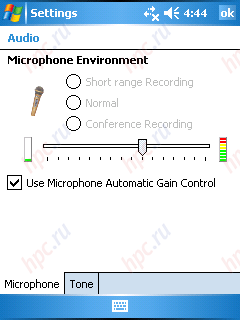 |
In addition, in the compilation of software for PDAs have a proprietary program for working with records - FSC VoiceRecording. This tool allows you to choose which will be a record - in the internal memory or flash card.
Sociability
With regard to communications, the LOOX N520 is clearly made with a corporate slant: Wi-Fi is, and needs a lot of Bluetooth is not. Given the built-in GPS and Russian reality (weak propagation of access points), it would be interesting to have a machine with it "tooth", for example, to pump tube to navigate through the system PocketGPS Pro Moscow c cell phone, or simply connect to the Internet.So for Russian users may be more effective investment of money becomes younger model N500, but it would depend on final prices. To study copy utilities to use GPS and Wi-Fi have not been established. Therefore, the software simply refused to detect the module GPS, and Wi-Fi had to run third party programs. But he worked the last "Hurrah." In addition to my own, discovered the two neighboring nets and tried to cut through them, but the hacker wars with neighbors, I did not meditate. According to the experience of working with the same GPS PDA Asus MyPal A636 based on WM 5.0, it can be assumed that the production copies N520 icon will appear with the settings of GPS. It will be possible to choose the port on which the program (such as PocketGPS Pro) will look for him, or let the program scan all ports. Incidentally, in the A636 wireless connectivity easy way to start clicking on the icons that appear at the bottom of the screen. I guess that would also work Wi-Fi and selling versions LOOX N520. It is known that part of their utility software will CONNECTMOBILITY - E2C - for easy setup of wireless connections. Of the communication capabilities PDA may also be noted and the infrared port, which is supported by standard software. In general, it is useful to exchange business cards c those who do not have the adapter 802.11. In preparing the article, it became known that the serial delivery will include a program for navigating from "Kiberso" that supports WM 5.0. In the meantime I tried to put PocketGPS Pro. System installed and running on the road rugnuvshis that I put it on your own risk (it's a new Windows "blood" or, more precisely, in the code). I have already said that in an existing instance N520 GPS receiver did not work, so that test by appropriate opportunities instance failed. In the meantime, we can say that in terms of GPS in N520 everything should be fine, because the chip SiRF Star III, which is embedded in our sample - the most popular to date among the manufacturers of GPS solution for integration into PDAs. On the possibilities of this receiver, we told the review Pocket Navigator PN-169: GPS-navigation "from a different point of view." In addition, the navigation department "MakTsentr reported that there is a development PocketGPS Pro Moscow, fully supports WM 5.0, which will be completed as soon as possible, so that without the navigation system we will not stay.
 |
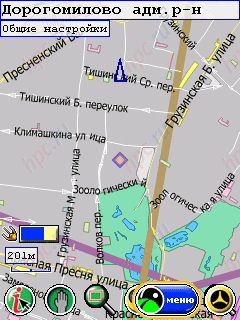 |
In the meantime, we can say that in terms of GPS in N520 everything should be fine, because the chip SiRF Star III, which is embedded in our sample - the most popular to date among the manufacturers of GPS solution for integration into PDAs. On the possibilities of this receiver, we told the review Pocket Navigator PN-169: GPS-navigation "from a different point of view."
Runtime
Thus, the PDA Pocket LOOX N520 was tested in four standard modes: - stress test - on Wi-Fi, in a series of heavy video was played, the backlight - at the maximum.
- Normal mode - an attempt to simulate some load average: Plays MP3, the screen - at an average level illumination is reading e-books.
- Reading - Program Haali Reader, for illumination of the first division, the processor is in power saving mode.
- Audio - turn off the backlight, is playing MP3, the processor is in power saving mode.
"In the race" with the LOOX N520 attended Asus MyPal A636 (review this PDA expect in the near future), Pocket Navigator PN-169 and the Acer n35. These results are given in view of the fact that the stress-test our hero was included Wi-Fi, but it is unclear whether the controller is activated GPS. Probably not, so that the performance of stress tests in serial samples are slightly lower.However, for car navigation, PDAs are typically connected to the cigarette lighter, and in other cases, an energy reserve for long enough. But still by far leads all competitors Asus A636. Our N520 took second place.
Software obespechenie
In addition to the standard set of software for PDAs running Windows Mobile 5.0, a set of Pocket LOOX N520 will contain the following corporate programs: - FSC SpeedMenu - firmware application menu shortcuts to frequently used applications.
- CONNECTMOBILITY-E2C - Manager, Wi-Fi connection.
- Voice Recorder - Voice recorder with enhanced features (such as the ability to record on a flash card).
- FSC Audio Path manages the audio stream can take it to the speaker, earphone, wireless headset.
- FSC Panning - scrolling web pages anywhere on the screen using the stylus. This is a more flexible version of viewing Web pages, because you can not aim at a thin strip of scroll bars and refuse to scroll through the hardware buttons.
- FSC KeyLock - key lock.
- FSC Password - set a password for access to the CCP, including synchronization.
Conclusions
To summarize. FSC decision to integrate the navigation module in the PDA of a new generation - much in the spirit of the times. It is gratifying that for these purposes is used best on the market, embedded GPS-chip - SiRF Star III. In this case, developers have managed to maintain a very compact size of the previous series LOOX 4xx, form factor which was to adopt and to abandon an external antenna. The last time - a serious advantage over the large-sized competitors. So that the FSC LOOX N520 is quite suitable for those who are going to use a novelty, not only as the onboard navigator, but also by direct PDA designation. Users who do not plan to work in networks of Wi-Fi, should pay attention to the younger model LOOX N500, without 802.11, which will cost less. I hope that the build quality of our sample is due only to its custom-built status and difficulties on the way to Russia. In short, be sure to soak in the hands of the CCP before buying. As for competitors, it certainly GPS PDA Acer n35, Mitac Mio 168RS/Pocket Navigator PN-169 of the old guard and the Asus MyPal A636 from recruits. From the first three LOOX N520 favorably support the new OS and a good battery life, and the latter the smaller sizes. If the FSC will implement its plans to sell the LOOX N520 at a price not more than $ 400, the unit will gain a high user rating.
Pros: - compact size
- nice design
- built-in GPS (no retractable antenna) on the SiRF Star III chip
- decent battery life
- good performance
- reasonable price
Cons: - Preproduction sample has a very flimsy enclosure
- The small size of flash memory available to user
- Lack of Bluetooth
- No scroll wheel
The authors, translation:
Alexander Baulin, scientific editor of the magazine "PC World"











